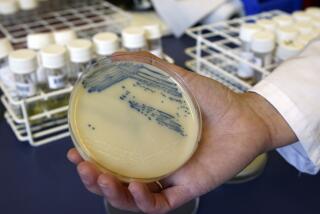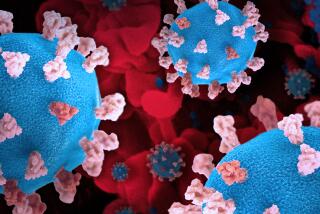Scientists Find Possible Key to Blocking Colds
- Share via
In a discovery that represents a major step toward a long-sought way to prevent and possibly treat the common cold, two groups of researchers announced Thursday that they have identified the mechanism by which some cold viruses enter cells and may have found a way to block the infection.
Researchers from Harvard Medical School in Boston and Molecular Therapeutics Inc. of West Haven, Conn., independently reported they had identified and cloned a “receptor” molecule in nasal cells that many cold-causing viruses use to enter the body and produce the sniffles, sneezing and stuffiness common to the ailment.
Although experiments thus far have been limited to the test tube, both groups believe that they can use this knowledge to tie up viruses before they can cause colds.
“My colleagues and I feel the discovery . . . is an important scientific breakthrough,” Harvard pathologist Timothy A. Springer said at a news conference to announce the finding. “Eventually it may be possible from this molecule to develop a drug that prevents the common cold.”
Other researchers echoed Springer’s excitement. “It’s very exciting . . . an absolute breakthrough,” said microbiologist John LaMontagne of the National Institute of Allergy and Infectious Diseases in Bethesda, Md.
“I think it is a very important finding because it is the first time we’ve found a receptor for a virus whose structure we understand,” said virologist Daniel Littman of UC San Francisco.
But the researchers cautioned that it could be one to five years before the approach can be tested in humans. And even then the drugs would be most useful only to people who are at risk of infection.
Nonetheless, the researchers have high hopes that their approach will be successful. “It is clearly feasible to develop a treatment based on what we have learned,” Springer said.
Researchers have been frustrated in their cold-prevention efforts by the large number of viruses that are capable of producing colds. Most viral disease, such as smallpox, are caused by only one virus, and contracting the disease generally produces a lifelong immunity to further infections by that virus.
But at least 115 different rhinoviruses--so named because they enter the body through the nose to produce colds--together produce about half of all colds, and infection by one confers no immunity to any of the others. Similarly, development of an anti-cold vaccine would require use of all the viruses to be successful--clearly an overwhelming task.
About five years ago, however, virologist Richard Colonno of the Merck Sharpe & Dohme Research Laboratories discovered that as many as 90% of the rhinoviruses bind to one protein on the surface of nasal cells. The Harvard and Molecular Therapeutics groups report that they have isolated and characterized this protein, which they call intercellular adhesion molecule-1 (ICAM-1).
Interestingly, the two groups were not looking for the same thing. The Molecular Therapeutics group was searching for the rhinovirus receptor, but the Harvard group was trying to find the mechanism by which disease-fighting white blood cells bind to nasal cells (as well as to other cells in the body) as part of the inflammatory response to infections.
But when the Connecticut group identified the rhinovirus receptor, according to molecular biologist Alan McClelland, they found that their receptor molecule was identical to Springer’s ICAM-1. The groups decided to submit their reports to the same journal, and both papers appear in today’s issue of Cell.
ICAM-1 on the surface of nasal cells fits into a depression on the surface of rhinoviruses much like a key fitting into a lock. Researchers have envisioned two different ways of interfering with this binding, and thereby preventing infection of cells by the rhinoviruses and the development of colds: covering the key (ICAM-1) so that it can no longer fit into the lock, or making lots of copies of the key so that they can tie up all the locks before the virus can attach itself to the nasal cells.
Colonno has already tried the first approach. He reported in 1986 that he made antibodies to the rhinovirus-binding protein on nasal cells. The antibodies coat the protein so that it no longer fits the depression on the virus.
He then sprayed the antibodies into the noses of 13 human volunteers before deliberately exposing them to rhinoviruses. Only seven of the 13 volunteers developed colds, compared to 12 of 13 other volunteers who did not receive the nasal spray. And in those volunteers who received the nasal spray and did develop colds, the symptoms were much less severe than among those who did not receive the spray.
Because those antibodies were produced in mouse cells, Colonno feared that they would trigger an allergic reaction in some recipients, Merck spokesman Roy Walker said Thursday, so no further human trials have been attempted.
Both Springer and McClelland envision taking the opposite tack, flooding the nasal passage with millions of copies of the key that fits into the virus. Unfortunately, ICAM-1 itself is not a good candidate for this purpose because it is not water soluble and thus could not readily be administered to a patient in nose drops or a spray.
They are therefore trying to make smaller versions of the molecule that contain only the section of ICAM-1 that actually binds to the virus. Springer said that his group has already made such a molecule, but he would not say whether it would bind to the virus and prevent infection. Because such molecules would presumably have to be studied first in the test tube and then in animals, clinical trials in humans could be several years away.






